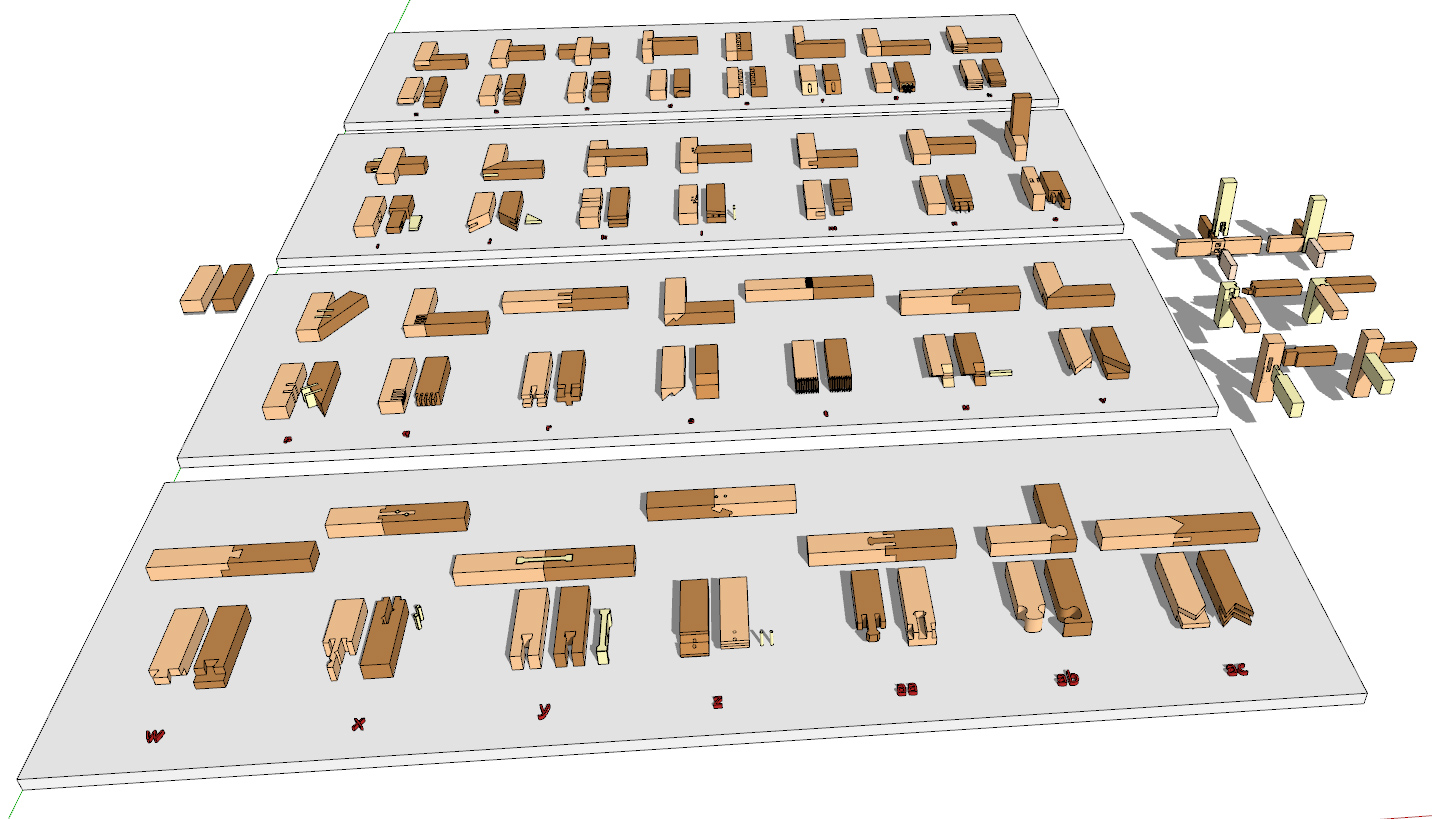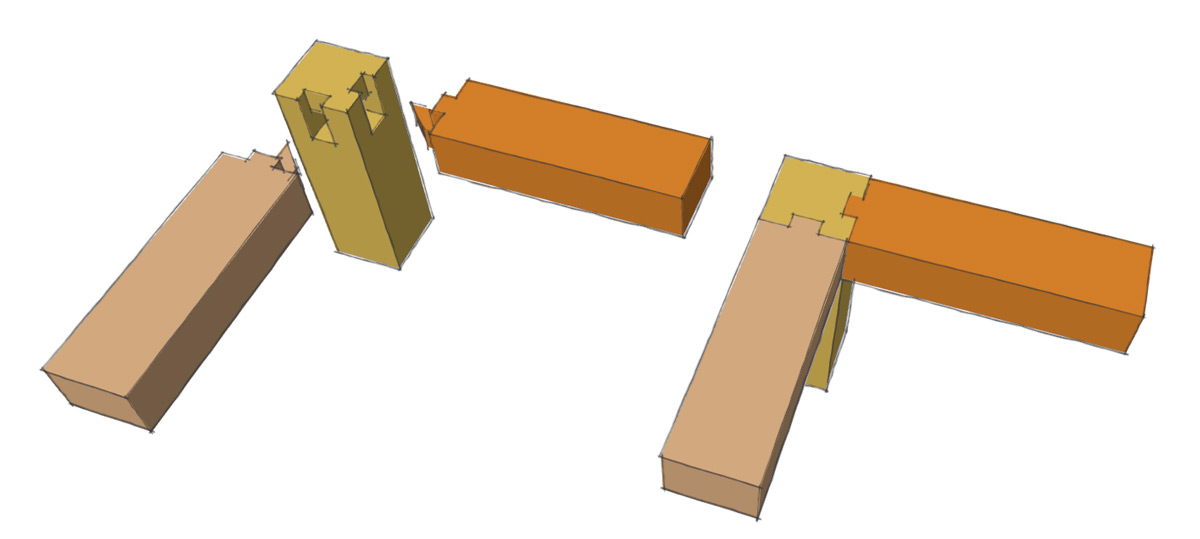Mortise and Tenon collection
-
I've created a little collection of wood joints.
If you know any names of them, I will collect them in this post to complement the model...
Dave collected an almost complete list later in this topic. Thank you!
(Downloads first version: 65)
-
Thanks.
A useful collection.
There are many www sites naming wood-joints...
http://woodworking.about.com/od/joinery/tp/JoineryHub.htm
http://www.raygirling.com/wwjoints.htm
http://www.mr-dt.com/manufacturing/woodjoints.htm
http://www.ripsdiy.co.za/woodjoins.shtml#topI'm sure Dave R as our resident joinery guru will give the best definitive answers...
-
Could you possibly post a Version 8 copy? Many thanks, Bob
-
@watkins said:
Could you possibly post a Version 8 copy? Many thanks, Bob
I've added a SU7 version...
-
@tig said:
Thanks.
A useful collection.
There are many www sites naming wood-joints...
...Thank you.
Modeling them from a quick image search was a lot of fun, but searching for the correct english names will be no fun (for me), so I will not do this
@tig said:
I'm sure Dave R as our resident joinery guru will give the best definitive answers...
Yes, and to be honest, I've started modeling this after watching his Basecamp woodworking video

-
thx for nice collection. names would be handy. some of them seems to made-up by you and very difficult to manufacture.
-
@jarynzlesa said:
some of them seems to made-up by you and very difficult to manufacture.
They all are modeled after images found via google image search...
-
Nice work, Carsten. I'm glad my video inspired you to do that.

Here's what I've come up with for those joints.
a. Half lap
b. ?
c. Halving joint
d. Sliding dovetail (these might be tapered, too)
e. Dovetail joint
f. Mortise and tenon. (both parts of the joint could get the same socket and a loose tenon added between. Festool’s Domino is a tool for cutting those)
g. Dowel joint
h. Twin bridle joint
i. Tusk tenon (the mortise in the tenon for the wedge should have the same slope so driving the wedge in will pull the tenoned piece up tight against the other piece)
j. Splined miter
k. Bridle joint
l. Pegged mortise and tenon.
m. Haunched mosrtise and tenon (typically used on doors. The tenons go on the rails, mortises on the stiles. The haunches fills the groove for the panel at the ends of the stiles)
n. Fox wedged mortise and tenon (the wedges get driven when they hit the bottom of the mortise. Tricky joint to execute correctly because you only get one chance to assemble it. If the wedges aren’t thick enough to expand the tenon fully, the joint can be loose. If the wedges are too thick, you won’t be able to close up the joint properly. In either case, something usually gets destroyed in taking it apart again.)
o. A combination mortise and tenon with sliding dovetail. There might be a Japanese name for it but it is basically a decorative joint.
p. ?
q. Box joint (although it wouldn’t be used with the pieces oriented as they are)
r. ? (might be useful for butt joining two piece of wood but it would be more decorative than functional. It provides some long grain gluing surfaces but sets up stress risers in all the corners so strength might not be that great.
s. ? Decorative and difficult to cut correctly.
t. Finger joint (common for joining short lengths of wood together. Probably much stronger than [r]. Typically seen in manufactured trim which will get painted.)
u. ? (looks like some sort of keyed birds mouth scarf joint. It would be decorative but not very strong. Without glue the only thing holding it together is the very small hooks that come up around the peg. Being very short grain, they would likely fail if there were any stress on the joint. The angled faces would provide decent gluing surface area but at that angle, they’d be 50% end grain. End grain doesn’t glue very well.
v. Mitered half lap. From one side it looks like a miter and the other a half lap joint. It can be a very good joint for frames because you get some good, long grain gluing area with the appearance of a miter. -
b. That is something like a dovetail-tenon, but it has an added partial half-lap component so that the dovetail is hidden - making it look like a weak half-lap that could be pulled out, whilst inside it's stronger, with the dovetail that locks itself in ?
-
It might be a bit stronger but if glue is used, the joint is probably more work than it is worth. The glue will be stronger than the wood anyway.
-
Personally I'll go with the unlisted joint and probably forget what I was going to
-
@box said:
Personally I'll go with the unlisted joint and probably forget what I was going to
You can do that in Colorado.

-
The version 7 is actually version 2014. Could you please save again in version 7 or 8.
Thanks,
Bob -
@watkins said:
The version 7 is actually version 2014. Could you please save again in version 7 or 8.
Thanks,
BobSorry, I've replaced it.
-
Nice collection. I have never made puzzle joints like this mortise and tenon, but it would be a fun challenge
Joint.pdf -
Thank you. Although I am not likely to use them, my partner was very interested as he's studying carpentry.
-
@jtri said:
Nice collection. I have never made puzzle joints like this mortise and tenon, but it would be a fun challenge
Here we go...

Download: see first post
-
Nice1
-
Well for my next project I will need to find a way to add that joint into the design. I have a Japanese double mortise chisel that will be perfect to chop the motices. This will be fun on the bench.
-
Another one...

Download: see first post
Advertisement







